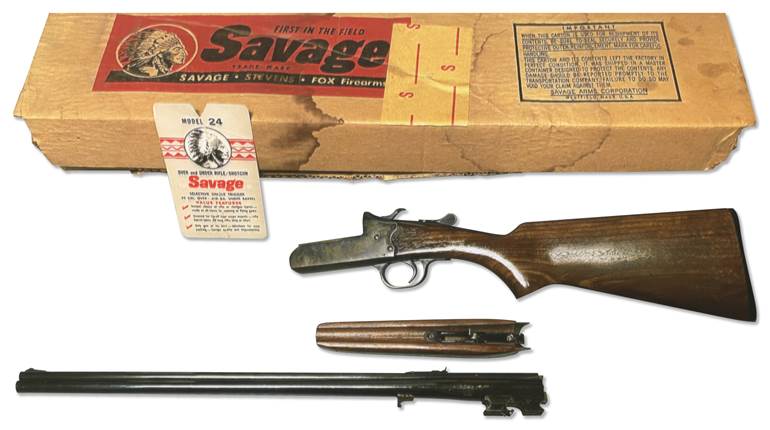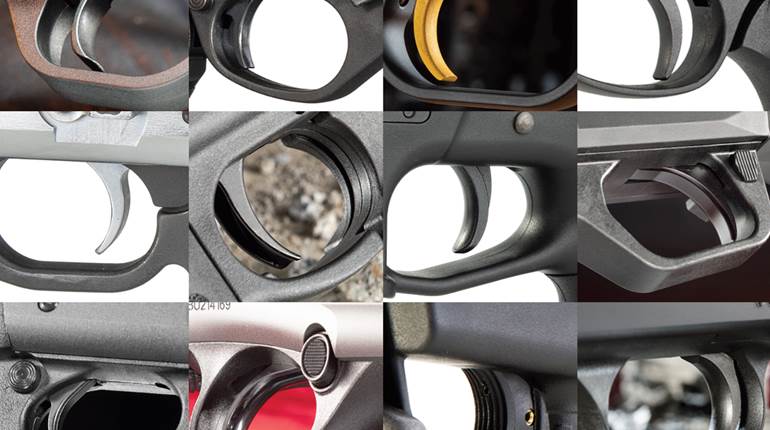
This factory-provided ghost image of the Impulse rifle’s mechanism reveals the cam at the rear of the bolt assembly and the balls at the front that effect the action’s lockup.
Before hunting wild boars in Bulgaria with a borrowed straight-pull rifle, I certainly didn’t appreciate the design’s genius. But after connecting with, not one, but three of four Russian boars that broke in rapid succession from the conifers one afternoon, charging like bristle-haired wrecking balls, I came to see how rapidly and intuitively a straight-pull can be manipulated—especially while under pressure. Indeed, I was convinced it is a superior bolt design, a better mousetrap, and I wanted one for hog hunting in my native American heartland. So, why didn’t I own a straight-pull? Because they were just too darned expensive. That changed in January of 2021, when Savage Arms unveiled its latest creation: the Impulse, an American-made straight-pull bolt-action rifle that’s fast, accurate and affordable. Recently, I was fortunate enough to give it a thorough workout in Texas, and here is what I found.
What’s The Point?
While I’ll speculate that some American hunters and shooters might mumble, “Why do we need this?” I’m not one of them. I know why. And besides, “need” is a word readily used by communists. Americans, rather, are secretly admired around the world for saying, “Why the heck not!?” But to answer the question of “why” from Savage’s perspective, I asked the company. President and CEO Al Kaspar wanted to grow the company’s international business, so he challenged the team to come up with ideas.
“We knew straight-pulls were popular in Europe, and we understood why,” said Beth Shimanski, the firm’s director of marketing. “So we evaluated the feasibility and market analysis. Fairly early on, we realized it could have legs everywhere.
“We felt we could bring a faster-cycling firearm to a wider variety of hunting and shooting categories. The speed, combined with accuracy, offers a great rifle for Precision Rifle Series (PRS) and Nation Rifle League (NRL) competitions as well as big-game hunts,” she continued. “We felt we could offer a better product in this category at a more affordable price point—both in the U.S. and abroad. That’s why.”
No doubt readers of this publication are fully aware that straight-pull bolt designs are nothing new. The Austro-Hungarian Empire’s Steyr-produced, Mannlicher-designed straight-pull Model 1886 came on the scene even before the adoption of the French bolt-action Lebel and years before the American bolt-action Springfield 1903. Why? Mainly because its two strokes (back, forward) were faster than a turnbolt’s four (up, back, forward, down), and during the frontal-warfare era, rate of fire was everything.
Dozens of straight-pull bolt-action rifles have been produced since 1886, but some of the more modern ones (excepting myriad T-Bolt rimfires) include: the Mauser M 96, Merkel Helix, Heym SR 30, Anschutz 1927, Blaser 93 and R8 and Browning Maral. What do all of them (except the Browning) have in common? They’re all made in Europe. Why? Because in that part of the world, driven-game hunting is the most popular style of hunting. Multiple quick shots are often required to down moose, deer and boar as they bound away from dog and driver. Both the speed of the straight-pull and the way the rifle can be swung smoothly in line with a running target as the bolt is worked on a linear plane is superior to the herky jerkiness of a traditional bolt. Well, that and because semi-automatics were mostly banned there by the communists.
What else do these rifles have in common? They’re all engineered extremely well—as the Europeans tend to do. On top of that and Europe’s labor costs, these rifles are typically embellished to satisfy the tastes of the elite class who typically hunt there. That is not to disparage those fine folks, rather just to make the point that their rifles tend to be pricey. The spectacularly innovative and refined Blaser R8, for example, ranges from $4,000 to $15,000!
On the other hand, Americans’ history of hunting was born not from the entertainment of kings but from necessity. American hunters chose Marlin lever-actions, Winchester bolt-actions and even Browning BARs if they really felt they needed to sling lead. But rarely did they, preferring instead the one-shot, one-kill mantra that prioritized accuracy. And so the European-style straight-pulls never caught on here.
But the Savage Impulse could change that since it is sub-m.o.a. accurate out of the box like the company’s Model 110, modular for customizing for specific uses like a Blaser and capable of ambidextrous operation. It’s safe and reliable, and yet it’s affordable at around $1,400. So far, I can’t find any drawbacks.
The author fired more than 500 rounds through various Impulse models, achieving sub-m.o.a. accuracy. Note the case in midair.
A Strong Action
I’ll list the Impulse’s familiar features swiftly so I can spend more time on the real story here, its action. Savage utilized existing rifle components from its vaunted Model 110 as the building blocks of the Impulse, and because the firm didn’t have to start from scratch, production was streamlined and costs were mitigated.
The Impulse contains most every notable piece of modern rifle technology Savage offers. And if you’ve ever wondered why Savages are so accurate, the following features (plus its barrels and barrel-nut systems) are the honest answer. The Impulse has a drop-in trigger housing with the safe and adjustable AccuTrigger. It differs from the 110’s, however, in that it can be adjusted from 2 lbs., 8 ozs., to 6 lbs. without removing the action from the stock. The AccuStock is basically an aluminum chassis embedded in a molded synthetic stock. The AccuStock was incorporated into higher-end Savage rifles before bare chassis rifles became cool. Rather than using two screws to hold the action into the stock and a simple slot to contain the recoil lug, the AccuStock provides three-dimensional, full-length support for the action and features a wedge of metal that clamps the recoil lug in place like a vise. It’s ingenious and incredibly effective for consistent accuracy in any weather, shot after pounding shot

The Impulse’s new AccuFit stock signifies that its buttstock is adjustable for length of pull via buttpad spacers and that its comb height is adjustable via modular cheekpads. The importance of obtaining a perfect cheekweld that consistently aligns the eye with the optic cannot be overstated for snap shooting as well as long-range precision.
Finally, a medium-contour, fluted, button-rifled, hand-straightened and 5/8x24 TPI-threaded Savage 110 barrel is utilized on the Impulse’s initial three models: the Big Game, Hog Hunter and Predator. No doubt it’s a heavier barrel than many everyday whitetail hunters may prefer, but Savage reps promise that lighter-barreled models—along with drop-in barrel kits—are forthcoming. Now, here’s where the Impulse goes all Euro on us.
Rather than utilizing a steel receiver, the Impulse’s floating-bolt-head design allowed for the use of an aluminum receiver. Why? Because a steel barrel extension serves as the lockup point to the bolt and therefore receives all the pressure from the fired round. The extension slides into the receiver—a little like a semi-automatic shotgun’s assembly—and is secured via a four-bolt barrel clamp. This critical barrel-extension design serves other purposes, too.
To some American shooters, the prospect of a straight-pull rifle blowing up seems scarier and more likely than with traditional bolt-actions. Since the bolt is designed to come straight back—without its handle first being lifted from its bay and its steel lugs rotated from their recesses as in traditional bolt-acton designs—it seems possible that a straight-pull malfunction could leave you looking rather like Phineas Gage. Perhaps this is a reputational holdover from the Ross straight-pull rifle that reportedly blew up in the faces of Canadian soldiers during World War I. Regardless, Savage designed the Impulse’s steel barrel extension to sever in the event of a catastrophic failure, thereby directing danger away from the shooter. Savage’s system was tested to 150,000 p.s.i.
The fluted barrel is threaded 5/8x24 TPI at the muzzle, and a knurled protector is included.
Furthermore, the extension allows for a lighter aluminum receiver that shaves weight from the overall rifle. I’m thankful for this, because the current Impulse is no lightweight. The extension is threaded onto the barrel with Savage’s vaunted locknut, so headspace is adjustable.
But mainly, the extension provides the lockup face for Savage’s “Hexbolt,” a floating, interchangeable bolt head that encircles six 9/32" steel ball bearings. Although Savage was awarded 13 patents in the process of making the Impulse, the ball-bearing bolt system isn’t new; the Hexbolt most closely mirrors Heym’s SR 30. “It was the strongest we could find,” Andy Sunseri, senior product design engineer, said bluntly.
Here’s how it works: By pushing the bolt handle forward and chambering a cartridge, a plunger rod is sent through the hollow shaft of the bolt and into the bolt head, thereby causing the outer half of each ball bearing to rise from its hole and uniformly lock into an annular recess, or channel, machined into the inside of the barrel extension. This system allows the bolt, chamber and barrel to function as a uniform unit, with correct headspace, each and every shot.
“Some straight-pulls are not known for accuracy,” said Senior Brand Manager Jessica Treglia. “They pride themselves on a quick follow-up shot, but if they can get a two-inch group, they’re happy. But that isn’t going to work here. We are Savage.” And she’s got a point.
When a shot is fired, pressure from the round forces even more pressure under the ball bearings, thereby tightening its bite relative to each load—the more pressure, the stronger the bite. After firing, a simple rearward levering of the rotary bolt handle changes the relationship of a small, teardrop-shaped cam located in the rear of the bolt, causing it to release pressure on the rear of the plunger, thereby retracting it. This releases pressure on the ball bearings, causing them to withdraw back into their holes, thus relinquishing their bite on the extension and allowing the bolt to slide back via continued rearward linear force on the bolt handle by the shooter. From there, the fired case is extracted by an SR 30-type clip and ejected via a Mauser 98-style fixed ejector on the receiver wall before another round can be pushed from the Model 110-style detachable box magazine.

Thoughtful Features
The flush-fitting, polymer (the one we have is all-metal) magazine in the Big Game and Hog Hunter models holds three or four rounds, depending on the chambering, while the Predator version features a 10-round metal AICS magazine and one-piece bottom metal.
The bolt head, as well as the entire modular bolt system down to the firing pin, can be fieldstripped with no tools. The cylindrical steel bolt’s body is 1/2" longer than those of typical Savage 110 actions of the same action length. The bolt handle and knob are separate pieces from the bolt body, with the handle being inserted into a pinion-type gear from either side of the receiver—that’s right, the rifle can be configured for either left- or right-hand operation. Once the handle is removed, its angle relative to the bolt axis can be set according to user preference before reassembly without tools by merely depressing the bolt-hole cap plunger button and then sliding off the cap to release its lock on the bolt handle. As a product of this pinion-gear design, the bolt can be kept in four different positions for each side of the gun. The bolt’s removable handle also serves as a key to the rifle; it cannot be removed when a round is chambered. Without it, the rifle cannot be loaded or fired.

Along with Savage’s tang-mounted, two-position safety and its centrally positioned magazine release lever, the reversible bolt makes the Impulse adaptable for ambidextrous use. The only exception is the fixed, right-side ejection port. Though the safety locks the bolt in the closed position while on “safe,” a nifty bolt release button on the rear of the receiver allows for one-handed opening of the bolt—even if the action is cocked, locked and on safe.
The receiver itself features an integrally machined Picatinny rail with 20 minutes of angle built in. For this, I’d like to give Savage an award solely for making hunters’, shooters’ and gunwriters’ lives easier. It eliminates the need for scope bases. Just buy Picatinny rings for your scope, tighten them to the rail, and you’re done. Finally, the entire rifle’s metal is Cerakoted Hazel Green on the Big Game model and finished matte black on the Hog Hunter and Predator.
Thanks to the interchangeable bolt head, uniform bolt thickness and the barrel extension being part of the barrel, the Impulse is fully modular, and this is part of its genius. While a long-action cartridge cannot be made to fit in a short-action Impulse, a long-action Impulse can be converted to fire a short-action chambering. For example, if you buy an Impulse in .300 Win. Mag., you can then buy a 6.5 mm Creedmoor barrel, bolt head and magazine, and swap them out in minutes. Remember about a decade ago when Thompson/Center’s Encore Pro Hunter $900 single-shot was all the rage because shooters could swap chamberings? I’ll take this new repeater for $1,400, Alex. Thanks.
The author spent time with the Impulse at FTW Ranch in Texas where targets ranged from static bullseyes to simulations of charging game.
Field Test
While at Texas’ famed FTW Ranch, I fired more than 500 rounds from all three Impulse models chambered in various cartridges, but mainly .308 Win. and 6.5 mm Creedmoor. The five Impulses I fired averaged sub-m.o.a. groups with Hornady Match ELD-X ammunition, with excellent Zeiss optics installed. But more impressive was the rifles’ speed, both in terms of putting multiple shots on moving targets via FTW’s running-game course, but also upon charging papier-mache elephants and buffalo. The times I shot would be impossible with a Model 70. What’s more, for long-range shooting, the straight-pull action proved much more valuable than I’d anticipated. You see, when shooting beyond 1,000 yards, the spotter’s wind call, as well as being able to see the bullet’s impact, is critical. When you fire a round, you must note your impact and then adjust your hold and/or your wind call accordingly. But if it takes more than about five seconds to shoot a follow-up, there’s a good chance the wind will have shifted, at which time you must start the process anew. The Impulse allowed me to get perfectly set on the rifle, fire, note impact, then rack the bolt smoothly without disturbing my sight picture so I could send another shot within seconds.
As another unanticipated bonus, the following day, I noticed I was not nearly as sore as I normally am after lying prone shooting a bolt gun all day—for two reasons. One, the bolt takes less physical effort and less contorting of the shoulder in order to work it. Secondly, the Impulse, with its modular cheekpiece, buttpad and hefty weight, was a pussycat to shoot. The only negative I can find in the rifle so far, however, is that weight. It’s a pound heavier than I’d prefer for most of my hunting. But again, Savage says lighter models are on the way. For hog hunting, the rifle as-is, is perfect.
As if you can’t tell already, I am an advocate of straight-pull bolt-actions. And I’m a fan of Savage rifles for the value they represent. While $1,400 is more expensive than we’re used to seeing from this purely American gunmaker, the Impulse is packed with so many features—and is modular, so it can evolve with you—that I don’t view it as overpriced. In fact, right now, if a friend wanted one bolt-action rifle for everything, from hog and deer hunting, to long-range target shooting and even PRS-style (non-AR) competition, I’d point him or her toward the Impulse. Why? Because I don’t think there’s a better rifle value on the market—here or across the pond. And that’s exactly why I bought one for myself.






































